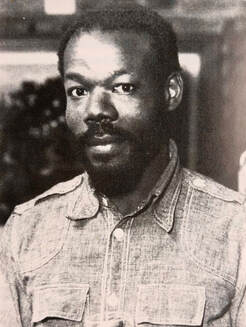|
Cleveland Brown 1943-2011 Jubilee Special 1977 Oil on canvas 40 x 51 inches (102 x 130 cm) PROVENANCE S.D. Bailey Esq; Private Collection. LITERATURE George Melly, A Tribe of One: Great Naive Painters of the British Isles, London 1981, pp.46-7 repr. £12,400 |
Cleveland Brown Jubilee Special (detail)
|
I believe him to be touched, and I never use the word lightly, by genius.
(George Melly writing about Cleveland Brown) Cleveland Brown was born in St Catherine, Jamaica, and grew up in a strict religious household where newspapers, television or going to the cinema were forbidden. Part of the Windrush generation, in 1961 aged just 18 he emigrated to London, where he worked as a master carpenter. In 1973 he started working as a carpenter at Sotheby's where, not having previously been exposed to art, he began seriously to look at art. Brown was inspired to start making his own paintings, telling himself, he later said, that if he could make woodwork then he could master the mechanics of making art. In Jubilee Special the artist captures the rapturous spirit of 1977 and the Queen's Silver Jubilee. The Royal Family have come down to The Mall to walk among the crowds, accompanied by the Gold State Coach, and everyone poses in a line as if for a photograph. The picture is full of wonderful touches of warm humour - the accurately over the top costumes of many of the crowd or the Union-Jack bedecked dog leaning towards one of the horses. An embracing couple on the bottom left imitate the pose of the lovers in Gustav Klimt's Kiss. In an act of characteristic puckish naughtiness and subversive brilliance Brown has transformed the statue of Queen Victoria in front of Buckingham Palace. Famous for her straightlaced moral conservatism, here she is depicted with her breasts bared. Brown has usually been classified as a naive painter, and in George Melly's book A Tribe of One he is given the accolade of the greatest naive artist in Britain, sitting alongside such a figure as Alfred Wallis. The unspoilt vision of Brown's work is certainly apparent - yet it is accompanied by an inventiveness and originality which is the hallmark of all true art. There is also an interesting political dimension which resonates through Brown's work. He painted the Grunwick Protest pickets clashing with the police (1977) and The Spaghetti House siege (1975), subjects no other British artist chose to depict. In Jubilee Special he shows a racially diverse crowd that is harmonious and unified, a family that has come together as one to celebrate their monarch. This cannot be accidental. Knowing what we know of racism and social division in 1977, and which Brown was all too aware of, there is an idealist agenda in his depiction of the Jubilee. This is a country united and at ease with itself, and an image of how in a better world things could be. Cleveland Brown is represented in the Arts Council and other collections. Jubilee Special belongs in seam of narrative art reflecting British society and culture that stretches from William Hogarth to Grayson Perry. |
Cleveland Brown c.1977



